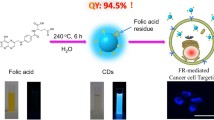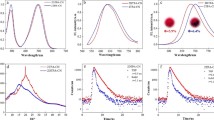Abstract
Fluorescent probes play a key role in modern biomedical research. As compared to inorganic quantum dots (QDs) composed with heavy metal elements, organic dye-based fluorescent nanoparticles have higher biocompatibility and are richer in variety. However, traditional organic fluorophores tend to quench fluorescence upon aggregation, which is known as aggregation-caused quenching (ACQ) effect that hinders the fabrication of highly emissive fluorescent nanoparticles. In this work, we demonstrate the synthesis of organic fluorescent dots with aggregation-induced emission (AIE) in far-red/near-infrared (FA/NIR) region. A conventional ACQ-characteristic fluorescent dye, 3,4:9,10-tetracarboxylic perylene bisimide (PBI), is converted into an AIE fluorogen through attaching two tetraphenylethylene (TPE) moieties. The fluorescent dots with surface folic acid groups are fabricated from PBI derivative (DTPEPBI), showing specific targeting effect to folate receptor-overexpressed cancer cells. In vivo studies also suggest that the folic acid-functionalized AIE dots preferentially accumulate in the tumor site through enhanced permeability and retention (EPR) effect and folate receptor-mediated active targeting effect. The low cytotoxicity, good FR/NIR contrast and excellent targeting ability in in vitro/in vivo imaging indicate that the AIE dots have great potentials in advanced bioimaging applications.
Similar content being viewed by others
References
Hong G, Lee JC, Robinson JT, Raaz U, Xie L, Huang NF, Cooke JP, Dai H. Multifunctional in vivo vascular imaging using near-infrared II fluorescence. Nat Med, 2012, 18: 1841–1846
Smith AM, Duan H, Mohs AM, Nie, S. Bioconjugated quantum dots for in vivo molecular and cellular imaging. Adv Drug Deliv Rev, 2008, 60: 1226–1240
Lewinski N, Colvin V, Drezek R. Cytotoxicity of nanoparticles. Small, 2008, 4: 26–49
Liu YS, Sun YH, Vernier PT, Liang CH, Chong SYC, Gundersen MA. pH-sensitive photoluminescence of CdSe/ZnSe/ZnS quantum dots in human ovarian cancer cells. J Phys Chem C, 2007, 111: 2872–2878
Qin AJ, Zhang Y, Han N, Mei J, Sun J, Fan W Tang BZ. Preparation and self-assembly of amphiphilic polymer with aggregation-induced emission characteristics. Sci China Chem, 2012, 55: 772–778
Hong Y, Lam JWY, Tang BZ. Aggregation-induced emission: Phenomenon, mechanism and applications. Chem Commun, 2009, 4332–4353
Yu Y, Hong Y, Feng C, Liu J, Lam JWY, Faisal M, Ng KM, Luo KQ, Tang BZ. Synthesis of an AIE-active fluorogen and its application in cell imaging. Sci China Ser B-Chem, 2009, 52: 12–19
Li HK, Mei J, Wang J, Zhang S, Zhao Q, Wei Q, Qin A, Sun J, Tang BZ. Facile synthesis of poly(aroxycarbonyltriazole)s with aggregation-induced emission characteristics by metal-free click polymerization. Sci China Chem, 2011, 54: 611–616
Hong Y, Lam JWY, Tang BZ. Aggregation-induced emission. Chem Soc Rev, 2011, 40: 5361–5388
Li K, Qin W, Ding D, Tomczak N, Geng J, Liu R, Liu J, Zhang X, Liu H, Liu B, Tang BZ. Photostable fluorescent organic dots with aggregation-induced emission (AIE dots) for noninvasive long-term cell tracing. Sci Rep, 2013, 3: 1150
Zhao Q, Zhang S, Lu Y, Mei J, Chen S, Lu P, Qin A, Ma Y, Sun JZ, Tang BZ. Tetraphenylethenyl-modified perylene bisimide: Aggregation-induced red emission, electrochemical properties and ordered microstructures. J Mater Chem, 2012, 22: 7387–7394
Prashant C, Dipak M, Yang CT, Chuang, KH, Jun D, Feng SS. Superparamagnetic iron oxide-loaded poly(lactic acid)-D-alpha-tocopherol polyethylene glycol 1000 succinate copolymer nanoparticles as MRI contrast agent. Biomaterials, 2010, 31: 5588–5597
Sudimack J, Lee RJ. Targeted drug delivery via the folate receptor. Adv Drug Deliv Rev, 2000, 41: 147–162
Low PS, Henne WA, Doorneweerd DD. Light-controlled release of caged doxorubicin from folate receptor-targeting PAMAM dendrimer nanoconjugate. Acc Chem Res, 2008, 41: 120–129
Geng J, Li K, Ding D, Zhang X, Qin W, Liu J, Tang BZ, Liu B. Lipid-PEG-Folate encapsulated nanoparticles with aggregation induced emission characteristics: Cellular uptake mechanism and two-photon fluorescence imaging. Small, 2012, 8: 3655–3663
Liu Z, Chen K, Davis C, Sherlock S, Cao Q, Chen XY, Dai HJ. Drug delivery with carbon nanotubes for in vivo cancer treatment. Cancer Res, 2008, 68: 6652–6660
Li SD, Huang L. Factors affecting the clearance and biodistribution of polymeric nanoparticles. Mol Pharmaceutics, 2008, 5: 496–504
Author information
Authors and Affiliations
Corresponding author
Rights and permissions
About this article
Cite this article
Li, K., Ding, D., Zhao, Q. et al. Biocompatible organic dots with aggregation-induced emission for in vitro and in vivo fluorescence imaging. Sci. China Chem. 56, 1228–1233 (2013). https://doi.org/10.1007/s11426-013-4936-3
Received:
Accepted:
Published:
Issue Date:
DOI: https://doi.org/10.1007/s11426-013-4936-3




